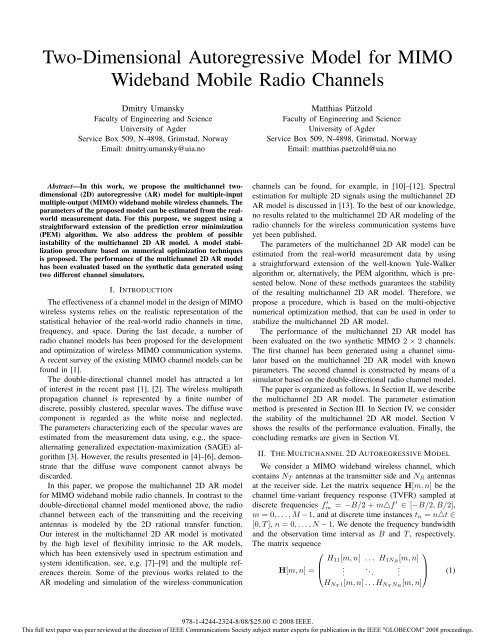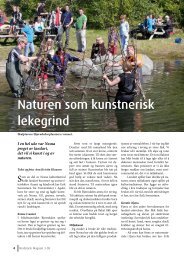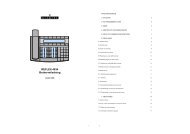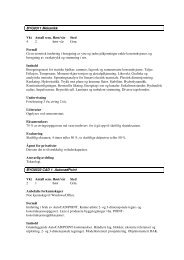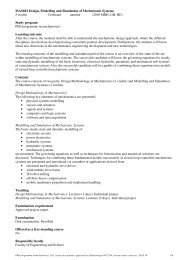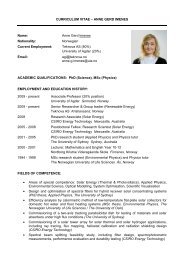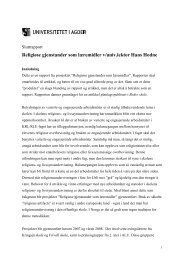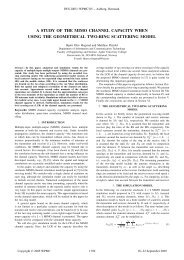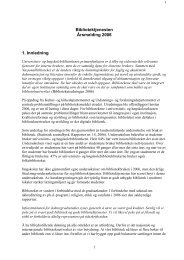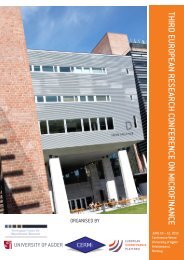A Two-Dimensional Autoregressive Model for MIMO Wideband ...
A Two-Dimensional Autoregressive Model for MIMO Wideband ...
A Two-Dimensional Autoregressive Model for MIMO Wideband ...
Create successful ePaper yourself
Turn your PDF publications into a flip-book with our unique Google optimized e-Paper software.
<strong>Two</strong>-<strong>Dimensional</strong> <strong>Autoregressive</strong> <strong>Model</strong> <strong>for</strong> <strong>MIMO</strong><br />
<strong>Wideband</strong> Mobile Radio Channels<br />
Dmitry Umansky<br />
Faculty of Engineering and Science<br />
University of Agder<br />
Service Box 509, N-4898, Grimstad, Norway<br />
Email: dmitry.umansky@uia.no<br />
Matthias Pätzold<br />
Faculty of Engineering and Science<br />
University of Agder<br />
Service Box 509, N-4898, Grimstad, Norway<br />
Email: matthias.paetzold@uia.no<br />
Abstract—In this work, we propose the multichannel twodimensional<br />
(2D) autoregressive (AR) model <strong>for</strong> multiple-input<br />
multiple-output (<strong>MIMO</strong>) wideband mobile wireless channels. The<br />
parameters of the proposed model can be estimated from the realworld<br />
measurement data. For this purpose, we suggest using a<br />
straight<strong>for</strong>ward extension of the prediction error minimization<br />
(PEM) algorithm. We also address the problem of possible<br />
instability of the multichannel 2D AR model. A model stabilization<br />
procedure based on numerical optimization techniques<br />
is proposed. The per<strong>for</strong>mance of the multichannel 2D AR model<br />
has been evaluated based on the synthetic data generated using<br />
two different channel simulators.<br />
I. INTRODUCTION<br />
The effectiveness of a channel model in the design of <strong>MIMO</strong><br />
wireless systems relies on the realistic representation of the<br />
statistical behavior of the real-world radio channels in time,<br />
frequency, and space. During the last decade, a number of<br />
radio channel models has been proposed <strong>for</strong> the development<br />
and optimization of wireless <strong>MIMO</strong> communication systems.<br />
A recent survey of the existing <strong>MIMO</strong> channel models can be<br />
found in [1].<br />
The double-directional channel model has attracted a lot<br />
of interest in the recent past [1], [2]. The wireless multipath<br />
propagation channel is represented by a finite number of<br />
discrete, possibly clustered, specular waves. The diffuse wave<br />
component is regarded as the white noise and neglected.<br />
The parameters characterizing each of the specular waves are<br />
estimated from the measurement data using, e.g., the spacealternating<br />
generalized expectation-maximization (SAGE) algorithm<br />
[3]. However, the results presented in [4]–[6], demonstrate<br />
that the diffuse wave component cannot always be<br />
discarded.<br />
In this paper, we propose the multichannel 2D AR model<br />
<strong>for</strong> <strong>MIMO</strong> wideband mobile radio channels. In contrast to the<br />
double-directional channel model mentioned above, the radio<br />
channel between each of the transmitting and the receiving<br />
antennas is modeled by the 2D rational transfer function.<br />
Our interest in the multichannel 2D AR model is motivated<br />
by the high level of flexibility intrinsic to the AR models,<br />
which has been extensively used in spectrum estimation and<br />
system identification, see, e.g. [7]–[9] and the multiple references<br />
therein. Some of the previous works related to the<br />
AR modeling and simulation of the wireless communication<br />
channels can be found, <strong>for</strong> example, in [10]–[12]. Spectral<br />
estimation <strong>for</strong> multiple 2D signals using the multichannel 2D<br />
AR model is discussed in [13]. To the best of our knowledge,<br />
no results related to the multichannel 2D AR modeling of the<br />
radio channels <strong>for</strong> the wireless communication systems have<br />
yet been published.<br />
The parameters of the multichannel 2D AR model can be<br />
estimated from the real-world measurement data by using<br />
a straight<strong>for</strong>ward extension of the well-known Yule-Walker<br />
algorithm or, alternatively, the PEM algorithm, which is presented<br />
below. None of these methods guarantees the stability<br />
of the resulting multichannel 2D AR model. There<strong>for</strong>e, we<br />
propose a procedure, which is based on the multi-objective<br />
numerical optimization method, that can be used in order to<br />
stabilize the multichannel 2D AR model.<br />
The per<strong>for</strong>mance of the multichannel 2D AR model has<br />
been evaluated on the two synthetic <strong>MIMO</strong> 2 × 2 channels.<br />
The first channel has been generated using a channel simulator<br />
based on the multichannel 2D AR model with known<br />
parameters. The second channel is constructed by means of a<br />
simulator based on the double-directional radio channel model.<br />
The paper is organized as follows. In Section II, we describe<br />
the multichannel 2D AR model. The parameter estimation<br />
method is presented in Section III. In Section IV, we consider<br />
the stability of the multichannel 2D AR model. Section V<br />
shows the results of the per<strong>for</strong>mance evaluation. Finally, the<br />
concluding remarks are given in Section VI.<br />
II. THE MULTICHANNEL 2D AUTOREGRESSIVE MODEL<br />
We consider a <strong>MIMO</strong> wideband wireless channel, which<br />
contains N T antennas at the transmitter side and N R antennas<br />
at the receiver side. Let the matrix sequence H[m, n] be the<br />
channel time-variant frequency response (TVFR) sampled at<br />
discrete frequencies f m ′ = −B/2 +m△f ′ ∈ [−B/2,B/2],<br />
m =0,...,M−1, and at discrete time instances t n = n△t ∈<br />
[0,T], n =0,...,N− 1. We denote the frequency bandwidth<br />
and the observation time interval as B and T , respectively.<br />
The matrix sequence<br />
⎛<br />
⎞<br />
H 11 [m, n] ... H 1NR [m, n]<br />
⎜<br />
H[m, n] = ⎝<br />
.<br />
. ..<br />
⎟<br />
. ⎠ (1)<br />
H NT 1[m, n] ...H NT N R<br />
[m, n]<br />
978-1-4244-2324-8/08/$25.00 © 2008 IEEE.<br />
This full text paper was peer reviewed at the direction of IEEE Communications Society subject matter experts <strong>for</strong> publication in the IEEE "GLOBECOM" 2008 proceedings.
can be equivalently represented in the vectorized <strong>for</strong>m as<br />
⎛<br />
⎞<br />
H 11 [m, n]<br />
H 21 [m, n]<br />
h[m, n] =vec(H[m, n]) = ⎜<br />
⎟<br />
⎝ . ⎠<br />
H NT N R<br />
[m, n]<br />
where h[m, n] =[h 1 [m, n],h 2 [m, n],...,h NT N R<br />
[m, n]] T and<br />
h i [m, n], i =1,...,N T N R , is the sampled TVFR of the i-th<br />
subchannel. The operator (·) T denotes the transpose.<br />
We assume that each subchannel h i [m, n] of the vector<br />
sequence h[m, n] is a complex zero mean 2D wide-sense<br />
stationary (WSS) random process (random field). Furthermore,<br />
the vector sequence h[m, n] corresponds to the multichannel<br />
2D AR process of the <strong>for</strong>m<br />
h[m, n] =− ∑∑<br />
A T [i 1 ,i 2 ]h[m − i 1 ,n− i 2 ]+u[m, n]<br />
[i 1,i 2]∈S<br />
[i 1,i 2]≠[0,0]<br />
(3)<br />
where A[i 1 ,i 2 ] are complex matrix coefficients of dimensions<br />
N T N R × N T N R . The vector sequence u[m, n] is a complex<br />
multichannel 2D white noise with the matrix cross-correlation<br />
function (CCF) R uu [k, l] defined as<br />
R uu [k, l] =E{u ∗ [m, n]u T [m + k, n + l]} = P uu δ[k, l] (4)<br />
where δ[k, l] is the 2D Dirac delta function and P uu denotes<br />
the noise delay-Doppler power spectral density (PSD) matrix 1 ,<br />
which is constant. The operators E{·} and (·) ∗ represent the<br />
statistical averaging and complex conjugate, respectively.<br />
We also assume that the channel model (3) is recursively<br />
computable (causal) [14]. The two most commonly used<br />
support regions S that guarantees the recursive computability<br />
of the vector sequence h[m, n] are the finite nonsymmetric<br />
half-plane (NSHP) and the finite quarter plane (QP) supports<br />
[8]. In this article, we focus our attention on the multichannel<br />
2D AR models (3) with the finite QP support region S QP<br />
defined as<br />
(2)<br />
S QP = {[i 1 ,i 2 ]:0≤ i 1 ≤ p 1 , 0 ≤ i 2 ≤ p 2 }. (5)<br />
where (p 1 ,p 2 ) is the order of the multichannel 2D AR model,<br />
hence<strong>for</strong>th designated AR(p 1 ,p 2 ).<br />
Using the relationship between the input PSD and the output<br />
PSD of a linear shift invariant (LSI) multichannel 2D filter<br />
(see, e.g., [7], [13]) we define the delay-Doppler PSD matrix<br />
P hh (τ ′ ,f d ) of the <strong>MIMO</strong> wireless channel as<br />
where<br />
P hh (τ ′ ,f d )=H ∗ (τ ′ ,f d )P uu H T (τ ′ ,f d )△f ′ △t (6)<br />
H(τ ′ ,f d )=(I+<br />
p 1<br />
∑<br />
p 2<br />
∑<br />
i 1 =0 i 2 =0<br />
[i 1 ,i 2 ]≠[0,0]<br />
A[i 1,i 2]e −j2π(τ ′ i 1 △f ′ +f d i 2 △t) ) −1 (7)<br />
1 The diagonal elements of the delay-Doppler PSD matrix are the delay-<br />
Doppler spectra of the individual sub-channels h i [m, n] (2) at the certain<br />
delay and Doppler frequency. The off-diagonal elements correspond to the<br />
samples of the cross-subchannel delay-Doppler spectra.<br />
and τ ′ and f d are the propagation delay and the Doppler<br />
frequency, respectively. The matrix I is the identity matrix.<br />
III. ESTIMATION OF THE MODEL PARAMETERS<br />
Suppose that the sampled TVFR H[m, n] of the <strong>MIMO</strong><br />
channel is given to us. For example, the matrix sequence (1)<br />
can be obtained from a channel sounder during a measurement<br />
campaign.<br />
Assume that the order (p 1 ,p 2 ) of the multichannel 2D<br />
AR(p 1 ,p 2 ) model (3) is known. The parameters of the model,<br />
i.e., the matrix coefficients A[i 1 ,i 2 ] and the noise PSD matrix<br />
P uu , are to be estimated from the available matrix sequence<br />
H[m, n] (1) or, equivalently, from the vector sequence h[m, n]<br />
(2).<br />
A. Prediction Error Minimization<br />
The PEM method is based on the strong relationship existing<br />
between the AR modeling and the linear prediction<br />
problem [9].<br />
The linear <strong>for</strong>ward predictor of h[m, n] is defined as<br />
ĥ[m, n] =− ∑∑<br />
A T [i 1 ,i 2 ]h[m − i 1 ,n− i 2 ] (8)<br />
[i 1,i 2]∈S QP<br />
[i 1,i 2]≠[0,0]<br />
with the prediction error given by<br />
e[m, n] =h[m, n] − ĥ[m, n]. (9)<br />
Consequently, the prediction error power matrix can be written<br />
as<br />
Σ = E{e[m, n]e H [m, n]}. (10)<br />
For the finite-sample vector sequence h[m, n] (2) the estimator<br />
of the matrix Σ takes the <strong>for</strong>m<br />
1<br />
ˆΣ =<br />
(M − p 1 )(N − p 2 ) (Z + YX)H (Z + YX) (11)<br />
where the matrices Z, Y, and X are defined below<br />
⎡<br />
⎤<br />
h T [M − 1,N − 1]<br />
h T [M − 2,N − 1]<br />
Z = ⎢<br />
⎥<br />
⎣ . ⎦<br />
h T [p 1 ,p 2 ]<br />
(12)<br />
Y<br />
⎡<br />
=<br />
⎤<br />
h T [M − 2,N − 1] ··· h T [M − p 1 − 1,N − p 2 − 1]<br />
h T [M − 3,N − 1] ··· h T [M − p 1 − 2,N − p 2 − 1]<br />
⎢<br />
⎣<br />
.<br />
.<br />
..<br />
⎥<br />
.<br />
⎦<br />
h T [p 1 − 1,p 2 ] ··· h T [0, 0]<br />
(13)<br />
⎡<br />
⎤<br />
A T [1, 0]<br />
A T [2, 0]<br />
X = ⎢<br />
⎥<br />
⎣ . ⎦ . (14)<br />
A T [p 1 ,p 2 ]<br />
978-1-4244-2324-8/08/$25.00 © 2008 IEEE.<br />
This full text paper was peer reviewed at the direction of IEEE Communications Society subject matter experts <strong>for</strong> publication in the IEEE "GLOBECOM" 2008 proceedings.
The matrix coefficients A[i 1 ,i 2 ] of the multichannel 2D<br />
AR(p 1 ,p 2 ) model can be estimated by minimizing the sum of<br />
the estimated prediction error powers, i.e.,<br />
{Â[i1 ,i 2 ]}<br />
[i 1,i 2]∈S QP ,<br />
[i 1,i 2]≠[0,0]<br />
= min<br />
{A[i 1,i 2]}<br />
{<br />
trace<br />
(<br />
ˆΣ<br />
)}<br />
. (15)<br />
This is a linear least-squares estimation problem. The estimate<br />
of the matrix X (14) that minimizes (15) can be written<br />
as<br />
ˆX = −Y † Z (16)<br />
where Y † is the Moore-Penrose pseudoinverse of the matrix<br />
Y [15].<br />
The estimated noise delay-Doppler PSD matrix ˆP uu is equal<br />
to the residual prediction error power matrix ˆΣ min , obtained<br />
by substituting the solution ˆX (16) into (11).<br />
IV. MODEL STABILITY<br />
In order to use the multichannel 2D AR(p 1 ,p 2 ) model (3)<br />
as a channel simulator, the model must be stable. The channel<br />
model (3) is stable when the following condition is fulfilled<br />
[8]<br />
⎛<br />
⎞<br />
p 1<br />
det ⎜<br />
⎝ I + ∑<br />
∑p 2<br />
i 1=0 i 2=0<br />
[i 1,i 2]≠[0,0]<br />
A[i 1 ,i 2 ]z i1<br />
1 zi2 2<br />
⎟<br />
⎠ ≠0,<br />
<strong>for</strong> all {(z 1 ,z 2 ):|z 1 |≤1, |z 2 |≤1} (17)<br />
where z 1 and z 2 are complex variables.<br />
The PEM method, described in Section III, does not guarantee<br />
the stability of the resulting multichannel 2D AR(p 1 ,p 2 )<br />
model. Additionally, the stability test (17) is almost useless in<br />
practice due to the heavy computational load.<br />
A. State-space representation of the multichannel 2D AR<br />
model<br />
In the past years, a number of stability tests has been<br />
proposed <strong>for</strong> 2D recursive filters in state-space <strong>for</strong>m [16], [17].<br />
An attractive feature of the state-space representation is that it<br />
is directly applicable to multichannel 2D recursive filters, i.e.,<br />
to the multichannel 2D AR(p 1 ,p 2 ) model (3).<br />
In this article, we consider the 2D state-space model representation<br />
developed by Roesser [18]. The Roesser’s state-space<br />
model can be <strong>for</strong>mulated as follows [14]<br />
[ ] [ ][ ]<br />
xh [m +1,n] A11 A<br />
=<br />
12 xh [m, n]<br />
x v [m, n +1] A 21 A 22 x v [m, n]<br />
[ ]<br />
B1<br />
+ u[m, n]<br />
B 2<br />
h[m, n] = [ ] [ ]<br />
x<br />
C 1 C h [m, n]<br />
2 + Du[m, n] (18)<br />
x v [m, n]<br />
where x h and x v are the model state variable vectors. The<br />
model input u[m, n] and the model output h[m, n] in (18) are<br />
the same processes u[m, n] and h[m, n] as in (3).<br />
The two possible candidates <strong>for</strong> the model stability test of<br />
the Roesser’s state-space model are presented below [17].<br />
Fig. 1.<br />
u[ mn , ]<br />
x [ mn v<br />
, ]<br />
h[ mn , ] <br />
A[1, 0]<br />
z <br />
1<br />
2<br />
A[0,1]<br />
A[1,1]<br />
1<br />
z <br />
1<br />
x [ mn h<br />
, ]<br />
Flowgraph representing the multichannel 2D AR(1,1) model.<br />
The Roesser’s state-space model (18) is bounded input<br />
bounded output (BIBO) stable if<br />
{<br />
A11 is stable<br />
A 22 + A 21 (z 1 I − A 11 ) −1 (19)<br />
A 12 , |z 1 | =1 is stable<br />
where a square matrix, e.g., A 11 , is stable if the maximum<br />
magnitude of its eigenvalues is less than 1. The second<br />
possible group of stability criteria is defined as<br />
{<br />
‖A11 ‖ 2 < 1<br />
‖A 22 ‖ 2 + ‖A 21 ‖ 2 (1 −‖A 11 ‖ 2 ) −1 (20)<br />
‖A 12 ‖ 2 < 1<br />
where ‖·‖ 2 is equal to the largest singular value of the matrix.<br />
The criteria in (19) are sufficient and necessary conditions<br />
<strong>for</strong> the BIBO stability of the model (18). On the other hand,<br />
the criteria in (20) are sufficient but not necessary [17]. The<br />
experimental results show that the BIBO stability conditions<br />
(19) are more suitable <strong>for</strong> the stabilization procedure presented<br />
below, in spite of the obvious computational advantages associated<br />
with the stability test implemented according to the<br />
criteria in (20).<br />
To be able to apply the stability test (19), the multichannel<br />
2D AR(p 1 ,p 2 ) model (3) has to be converted to the Roesser’s<br />
state-space representation (18). The conversion between the<br />
model representations can be done in at least two ways.<br />
However, considering the computational load required to test<br />
the stability of the model, it is desirable to minimize the<br />
number of state variables, i.e., the length of the vectors x h and<br />
x v in (18). The minimal state-space realization of the model<br />
(18) can be obtained by assigning the state variables in x h and<br />
x v to the outputs of the shift operators in a signal flowgraph<br />
[14]. As an example, the flowgraph of a simple multichannel<br />
2D AR(1,1) model is presented in Fig. 1. The shift operators<br />
are indicated as z1 −1 and z2 −1 . The matrix coefficients A[i 1,i 2 ],<br />
i 1 ,i 2 = {0, 1}, are shown in Fig. 1 along the appropriate<br />
branches.<br />
The details related to the state-space realizations of the 2D<br />
filters can be found in [14].<br />
B. Stabilization procedure<br />
In this subsection, we briefly describe a procedure that<br />
resolves the possible instability of the multichannel 2D<br />
AR(p 1 ,p 2 ) model (3).<br />
Step 1. Estimate the matrix coefficients Â(0) [i 1 ,i 2 ] and<br />
(0)<br />
the noise delay-Doppler PSD matrix ˆP uu by minimizing the<br />
978-1-4244-2324-8/08/$25.00 © 2008 IEEE.<br />
This full text paper was peer reviewed at the direction of IEEE Communications Society subject matter experts <strong>for</strong> publication in the IEEE "GLOBECOM" 2008 proceedings.
sum of the estimated prediction error powers in (15) (see<br />
Section III).<br />
Step 2. Calculate the matrices A 11 , A 12 , A 21 , and A 22<br />
of the Roesser’s state-space representation (18). If the BIBO<br />
stability conditions in (19) are satisfied, skip the next steps.<br />
Step 3. Formulate the minimization problem (15) under<br />
constrains (19) as a multi-objective optimization problem that<br />
can be solved by the goal-attainment method [19], i.e.,<br />
min γ (21)<br />
γ∈R<br />
subject to<br />
( )<br />
( )<br />
trace ˆΣ − w 1 γ ≤ trace ˆP(0) uu<br />
ρ(A 11 ) − w 2 γ ≤ 1<br />
ρ(A 22 + A 21 (z 1 I − A 11 ) −1 A 12 ) − w 3 γ ≤ 1, |z 1 | =1<br />
where ρ(·) denotes the spectral radius of a square matrix [15],<br />
{w 1 ,w 2 ,w 3 } are the weighting coefficients that signify the<br />
relative trade-off between the objectives, and γ is a scalar<br />
parameter (see, e.g, [19], [20]). Note that the matrices ˆΣ,<br />
A 11 , A 12 , A 21 , and A 22 in (21) are functions of the matrix<br />
coefficients A[i 1 ,i 2 ], [i 1 ,i 2 ] ∈S QP , [i 1 ,i 2 ] ≠[0, 0]. Thesolution<br />
to the multi-objective minimization problem <strong>for</strong>mulated<br />
in (21) can be found by applying the fgoalattain function<br />
implemented in MATLAB. The estimates Â(0) [i 1 ,i 2 ] obtained<br />
at Step 1 can be used as the initial parameter values.<br />
Step 4. The matrix coefficients Â[i 1,i 2 ] obtained in Step 3<br />
are substituted into (14) to get the estimate of the matrix ˆX.<br />
Finally, the estimate of the noise delay-Doppler PSD matrix<br />
ˆP uu is equal to the residual prediction error power matrix<br />
ˆΣ min calculated by substituting the matrix ˆX into (11) (see<br />
Section III).<br />
A note regarding Step 2 and Step 3 of the algorithm<br />
described above is required. For the second stability criterium<br />
in (19) the largest magnitude eigenvalue of the corresponding<br />
matrix has to be calculated at the infinite number of points<br />
z 1 along the unit circle, |z 1 | =1. The conducted simulations<br />
suggest that a limited number of points z 1 is sufficient to check<br />
the stability of the multichannel 2D AR(p 1 ,p 2 ) model.<br />
V. SIMULATION RESULTS<br />
In this section, we present two examples that illustrate the<br />
per<strong>for</strong>mance of the multichannel 2D AR models. In each of<br />
the examples, the role of the measured 2×2 <strong>MIMO</strong> channel is<br />
played by a channel simulator, in the following referred to as<br />
the original model. Our task is to estimate the parameters of<br />
the multichannel 2D AR(p 1 ,p 2 ) model (3), the target model,<br />
from the TVFR matrix sequence ˜H[m, n] synthesized by using<br />
the original model.<br />
In the first example, the original model is the multichannel<br />
2D AR(2,2) model (3). Due to the lack of space and a<br />
relatively large number of parameters, we do not provide the<br />
matrix coefficients Ã[i 1,i 2 ] and the noise delay-Doppler PSD<br />
matrix ˜P uu of the original model.<br />
The parameters of the target multichannel 2D AR(2,2)<br />
model, i.e., the matrix coefficients Â[i 1,i 2 ] and the noise<br />
delay-Doppler PSD matrix ˆP uu , have been estimated from<br />
the training TVFR matrix sequence ˜H[m, n], 1 ≤ m ≤ 193,<br />
1 ≤ n ≤ 100, by employing the PEM method (see Section III).<br />
The BIBO stability test (19) shows that the resulting target<br />
multichannel 2D AR(2,2) model is stable.<br />
To evaluate the per<strong>for</strong>mance of the target multichannel<br />
2D AR(2,2) model, a test TVFR matrix sequence Ĥ[m, n]<br />
has been generated using the resulting target model. Another<br />
test TVFR matrix sequence ˜H[m, n], of the same length as<br />
Ĥ[m, n], has been obtained using the original model. The<br />
temporal cross-correlation functions (TCCF) ˆr hih j<br />
[k], k ∈ N,<br />
i, j = 1,...,N T N R , and the frequency cross-correlation<br />
functions (FCCF) ˆr hih j<br />
[l], l ∈ N, ofthetarget multichannel<br />
2D AR(2,2) model are estimated from the test TVFR matrix<br />
sequence Ĥ[m, n]. Similarly, the TCCFs ˜r h ih j<br />
[k] and the<br />
FCCFs ˜r hih j<br />
[l] of the original model are estimated from the<br />
test TVFR matrix sequence ˜H[m, n]. Some estimated TCCFs<br />
of the target model and of the original model are shown<br />
in Fig. 2. The corresponding estimated FCCFs are shown in<br />
Fig. 3.<br />
Absolute value<br />
Fig. 2.<br />
Absolute value<br />
Fig. 3.<br />
1<br />
0.8<br />
0.6<br />
0.4<br />
0.2<br />
0<br />
˜r h1h1[k] (original)<br />
˜r h3h2<br />
[k] (original)<br />
ˆr h1h1<br />
[k] (target)<br />
ˆr h3h2[k] (target)<br />
2 4 6 8 10 12 14<br />
Time lag, k<br />
The TCCFs of the target model and of the original model.<br />
1<br />
0.9<br />
0.8<br />
0.7<br />
0.6<br />
0.5<br />
0.4<br />
0.3<br />
0.2<br />
˜r h1h1<br />
[l] (original)<br />
˜r h3h2[l] (original)<br />
ˆr h1h1[l] (target)<br />
ˆr h3h2<br />
[l] (target)<br />
5 10 15 20<br />
Frequency lag, l<br />
The FCCFs of the target model and of the original model.<br />
As can be seen in Figs. 2 and 3, the selected TCCFs and<br />
978-1-4244-2324-8/08/$25.00 © 2008 IEEE.<br />
This full text paper was peer reviewed at the direction of IEEE Communications Society subject matter experts <strong>for</strong> publication in the IEEE "GLOBECOM" 2008 proceedings.
the FCCFs of the target multichannel 2D AR(2,2) model<br />
approximate well their respective counterparts of the original<br />
model. Similar results can be observed <strong>for</strong> other estimated<br />
temporal and frequency cross-correlation functions.<br />
The second example presents an extreme case in a sense<br />
that the generated TVFR matrix sequence (1) corresponds to<br />
the discrete multichannel 2D PSD, while the target model<br />
implies a continuous multichannel 2D PSD. The original<br />
model in this example, is a channel simulator based on the<br />
double-directional channel model [1]. In the double-directional<br />
model the wireless propagation channel is represented by a<br />
set of L complex exponents (multipath components). Each<br />
of these complex exponents is characterized by the complex<br />
amplitude, Doppler frequency, propagation delay, directionof-arrival,<br />
direction-of-departure, and, possibly, polarization<br />
matrix. In our double-directional model, the transmitter is<br />
stationary and the receiver is moving. The transmitter and<br />
the receiver are equipped with linear antenna arrays. Each<br />
of the antenna arrays consists of two (N T = N R = 2)<br />
omnidirectional single-polarization antenna elements separated<br />
by a half wavelength distance. The radio waves propagate in<br />
the azimuthal plane. Several other parameters are specified<br />
below<br />
• Number of multipath components: L = 530;<br />
• Time interval between snapshots: △t =10ms;<br />
• Signal carrier frequency: f ′ c =5.2 GHz;<br />
• Interval between frequencies: △f ′ =3.125 · 10 5 Hz;<br />
• Frequency bandwidth: B =60MHz;<br />
• Measurement noise SNR: 20 dB.<br />
The multipath components of the original model in the<br />
delay-Doppler plane are shown in Fig. 4.<br />
been estimated. All of the target models have been stabilized<br />
using the procedure described in Section IV-B.<br />
The TCCFs ˆr hih j<br />
[τ q ] of the resulting target models and the<br />
TCCFs ˜r hih j<br />
[τ q ] of the original model have been estimated<br />
from the generated test sequences Ĥ[m, n] and ˜H[m, n],<br />
respectively, at the discrete time lags τ q . Similarly, the FCCFs<br />
ˆr hih j<br />
[ν p ] of the resulting target models and the FCCFs<br />
˜r hih j<br />
[ν p ] of the original model have been estimated from the<br />
corresponding test sequences at the discrete frequency lags ν p .<br />
In Figs. 5 and 6, we demonstrate the estimated TCCFs and<br />
FCCFs, respectively, <strong>for</strong> the first subchannel of the resulting<br />
target models and of the original model.<br />
Absolute value<br />
1<br />
0.8<br />
0.6<br />
0.4<br />
0.2<br />
˜r h1h1[τ q ], (original)<br />
ˆr h1h1[τ q ], (target, p 1 =1,p 2 =1)<br />
ˆr [τ h1h1 q], (target, p 1 =3,p 2 =3)<br />
ˆr h1h1[τ q ], (target, p 1 =5,p 2 =5)<br />
0<br />
0 0.05 0.1 0.15 0.2 0.25<br />
Time lag, τ q (s)<br />
Fig. 5. The TCCF ˆr h1 h 1<br />
[τ q] of the target models and the TCCF ˜r h1 h 1<br />
[τ q]<br />
of the original channel.<br />
Magnitude<br />
x 10 −3<br />
6<br />
4<br />
2<br />
2 0 1<br />
Delay, τ ′ (ms)<br />
0<br />
−40<br />
40<br />
20<br />
0<br />
−20<br />
Doppler frequency, f d (Hz)<br />
Absolute value<br />
1.2<br />
1<br />
0.8<br />
0.6<br />
0.4<br />
0.2<br />
˜r h1h1[ν p ], (original)<br />
ˆr [ν h1h1 p], (target, p 1 =1,p 2 =1)<br />
ˆr [ν h1h1 p], (target, p 1 =3,p 2 =3)<br />
ˆr [ν h1h1 p], (target, p 1 =5,p 2 =5)<br />
0<br />
0 1 2 3 4 5 6<br />
Frequency lag, ν p (MHz)<br />
Fig. 4.<br />
The multipath components.<br />
Again, as in the first example, the training TVFR matrix<br />
sequence ˜H[m, n], 1 ≤ m ≤ 193, 1 ≤ n ≤ 100, has been<br />
generated using the original model and supplied to the PEM<br />
to estimate the parameters Â[i 1,i 2 ] and ˆP uu of the target<br />
multichannel 2D AR(p 1 ,p 2 ) model. In this case, the order of<br />
the target model is unknown. There<strong>for</strong>e, the parameters of the<br />
multichannel 2D AR(1,1), AR(3,3), and AR(5,5) models have<br />
Fig. 6. The FCCF ˆr h1 h 1<br />
[ν p] of the target models and the FCCF ˜r h1 h 1<br />
[ν p]<br />
of the original channel.<br />
As expected, a slightly better approximation of the correlation<br />
characteristics of the original channel can be achieved<br />
by increasing the order of the target model.<br />
The effect of applying the stabilization procedure to the<br />
target multichannel 2D AR(5,5) model can be observed in<br />
978-1-4244-2324-8/08/$25.00 © 2008 IEEE.<br />
This full text paper was peer reviewed at the direction of IEEE Communications Society subject matter experts <strong>for</strong> publication in the IEEE "GLOBECOM" 2008 proceedings.
Figs. 7 and 8 where we depict the delay-Doppler PSD 2 <strong>for</strong> the<br />
first subchannel be<strong>for</strong>e and after stabilization, respectively. The<br />
delay-Doppler PSDs of the target models have been calculated<br />
using (6) and (7).<br />
Power (dB)<br />
200<br />
150<br />
100<br />
50<br />
0<br />
4<br />
3<br />
2<br />
Delay, τ ′ (μs)<br />
1<br />
0<br />
−40<br />
40<br />
20<br />
0<br />
−20<br />
Doppler frequency, f d (Hz)<br />
Fig. 7. The delay-Doppler PSD <strong>for</strong> the first subchannel of the target<br />
multichannel 2D AR(5,5) model (be<strong>for</strong>e stabilization).<br />
Power (dB)<br />
200<br />
150<br />
100<br />
50<br />
0<br />
4<br />
3<br />
2<br />
Delay, τ ′ (μs)<br />
1<br />
0<br />
−40<br />
40<br />
20<br />
0<br />
−20<br />
Doppler frequency, f d (Hz)<br />
Fig. 8. The delay-Doppler PSD <strong>for</strong> the first subchannel of the target<br />
multichannel 2D AR(5,5) model (after stabilization).<br />
VI. CONCLUSION<br />
In this article, we have presented the multichannel 2D<br />
AR model <strong>for</strong> <strong>MIMO</strong> wideband mobile radio channels. The<br />
parameters of the multichannel 2D AR model can be estimated<br />
from the measured TVFR matrix sequence of a real-world<br />
channel. The model parameter estimation algorithm, described<br />
in the paper, is a straight<strong>for</strong>ward extension of the PEM method<br />
developed <strong>for</strong> estimating parameters of the multichannel 1D<br />
and 2D single-channel AR models.<br />
The main problem associated with the multichannel 2D AR<br />
model is a possible instability of the resulting channel model.<br />
2 Similar to the single-channel 1D case, the peak heights in the calculated<br />
delay-Doppler PSD are not proportional to the power of the exponents in the<br />
original signal [7], [8].<br />
The stabilization procedure proposed in this article can be used<br />
to stabilize the multichannel 2D AR model. However, due to<br />
the large number of the model parameters, the stabilization<br />
procedure might be time consuming even <strong>for</strong> the multichannel<br />
2D AR models of the moderate order, say p 1 > 5, p 2 > 5 <strong>for</strong><br />
2 × 2 <strong>MIMO</strong> systems.<br />
In this connection, it is important to study the per<strong>for</strong>mance<br />
and stability of the multichannel 2D AR models obtained<br />
from the real-world measurement data. The potential of the<br />
stabilization methods existing in the framework of the control<br />
system design, e.g., the model stabilization by means of the<br />
state or/and output feedback controllers, constitutes another<br />
topic <strong>for</strong> further investigation.<br />
REFERENCES<br />
[1] P. Almers, E. Bonek, A. Burr et al., “Survey of channel and radio<br />
propagation models <strong>for</strong> wireless <strong>MIMO</strong> systems,” EURASIP Journal<br />
on Wireless Communications and Networking, vol. 2007, pp. Article ID<br />
19 070, 19 pages, 2007, doi:10.1155/2007/19070.<br />
[2] M. Steinbauer, A. F. Molisch, and E. Bonek, “The double-directional<br />
radio channel,” IEEE Antennas Propag. Mag., vol. 43, no. 4, pp. 51–63,<br />
Aug. 2001.<br />
[3] B. H. Fleury et al., “Channel parameter estimation in mobile radio<br />
environments using the SAGE algorithm,” IEEE J. Sel. Areas Commun.,<br />
vol. 17, no. 3, pp. 434–450, Mar. 1999.<br />
[4] A. Richter, “Estimation of radio channel parameters: <strong>Model</strong>s and algorithms,”<br />
Ph.D. dissertation, Technische Universität Ilmenau, Ilmenau,<br />
Germany, 2005.<br />
[5] C. B. Ribeiro, E. Ollila, and V. Koivunen, “Stochastic maximumlikelihood<br />
method <strong>for</strong> <strong>MIMO</strong> propagation parameter estimation,” IEEE<br />
Trans. Signal Process., vol. 55, no. 1, pp. 46–55, Jan. 2007.<br />
[6] N. Czink, A. Richter, E. Bonek, J.-P. Nuutinen, and J. Ylitalo, “Including<br />
diffuse multipath parameters in <strong>MIMO</strong> channel models,” in 2007 IEEE<br />
66th Vehicular Technology Conf., (VTC-2007 Fall), Baltimore, MD,<br />
USA, Oct. 2007, pp. 874–878.<br />
[7] S. L. Marple, Digital Spectral Analysis with Applications. NJ: Prentice<br />
Hall, 1987.<br />
[8] S.M.Kay,Modern Spectral Estimation, Theory and Application. NJ:<br />
Prentice Hall, 1988.<br />
[9] P. Stoica and R. L. Moses, Spectral Analysis of Signals. NJ: Prentice<br />
Hall, 2005.<br />
[10] S. J. Howard and K. Pahlavan, “<strong>Autoregressive</strong> modeling of wide-band<br />
indoor radio propagation,” IEEE Trans. Commun., vol. 40, no. 9, pp.<br />
1540–1552, Sep. 1992.<br />
[11] K. E. Baddour and N. C. Beaulieu, “Accurate simulation of multiple<br />
cross-correlated Rician fading channels,” IEEE Trans. Commun., vol. 52,<br />
no. 11, pp. 1980–1987, Nov. 2004.<br />
[12] ——, “<strong>Autoregressive</strong> modeling <strong>for</strong> fading channel simulation,” IEEE<br />
Trans. Wireless Commun., vol. 4, no. 4, pp. 1650–1662, Jul. 2005.<br />
[13] C. W. Therrien and H. T. El-Shaer, “Multichannel 2-D AR spectrum<br />
estimation,” IEEE Trans. Acoust., Speech, Signal Process., vol. 37,<br />
no. 11, pp. 1798–1800, Nov. 1989.<br />
[14] D. E. Dudgeon and R. M. Mersereau, Multidimensional Digital Signal<br />
Processing. NJ: Prentice Hall, 1984.<br />
[15] C. D. Meyer, Matrix Analysis and Applied Linear Algebra. SIAM,<br />
2001.<br />
[16] E. I. Jury, “Stability of multidimensional scalar and matrix polynomials,”<br />
Proc. IEEE, vol. 66, no. 9, pp. 1018–1047, Sep. 1978.<br />
[17] T. Kaczorek, <strong>Two</strong>-<strong>Dimensional</strong> Linear Systems. Berlin: Springer-Verlag,<br />
1985.<br />
[18] R. P. Roesser, “A discrete state-space model <strong>for</strong> linear image processing,”<br />
IEEE Trans. Autom. Control, vol. 20, no. 1, pp. 1–10, Feb. 1975.<br />
[19] F. Gembicki and Y. Haimes, “Approach to per<strong>for</strong>mance and sensitivity<br />
multiobjective optimization: The goal attainment method,” IEEE Trans.<br />
Autom. Control, vol. 20, no. 6, pp. 769–771, Dec. 1975.<br />
[20] P. J. Fleming and A. P. Pashkevich, “Application of multi-objective optimisation<br />
to compensator design <strong>for</strong> SISO control systems,” Electronics<br />
Letters, vol. 22, no. 5, pp. 258–259, Feb. 1986.<br />
978-1-4244-2324-8/08/$25.00 © 2008 IEEE.<br />
This full text paper was peer reviewed at the direction of IEEE Communications Society subject matter experts <strong>for</strong> publication in the IEEE "GLOBECOM" 2008 proceedings.


